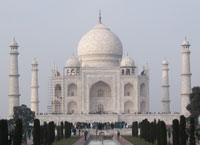 |
| Home Send Money to India Modes of money transfer India BPO India Tourism Taj Mahal Kumarakom Lakes Jaipur Pink city Alappuzha Backwaters Goa Tourism Munnar Hill Station India States Andhra Pradesh Assam Bihar Chattisgarh Goa Gujarat Haryana Himachal Pradesh Jammu and Kashmir Jharkhand Karnataka Kerala Madhya Pradesh Maharashtra Manipur Meghalaya Mizoram Nagaland Punjab Rajasthan Sikkim Tamil Nadu Orissa Tripura Uttar Pradesh Uttaranchal West Bengal India Quick Links Indiaweblinks World Wonders Web 123 Biotech Honeymoon Packages |
India States - Punjab  The Punjab state borders the Punjab province of Pakistan to the west, Jammu and Kashmir to the north, Himachal Pradesh to the northeast, Haryana to the south and southeast, the Union Territory of Chandigarh to the southeast and Rajasthan to the southwest. The total area of the state is 50,362 square kilometres. Punjab's capital is Chandigarh which is administered separately as a Union Territory since it is also the capital of neighbouring Haryana. Other major cities of Punjab include Amritsar, Ludhiana, Jalandhar and Patiala. The word "Punjab" is a combination of the Persian words 'Panj' five, and 'Aab' water, giving the literal meaning of the Land of the Five Rivers. The five rivers which Punjab is named after are the Jhelum; the Chenab; the Ravi; the Beas and the Sutlej. Punjab is a predominantly agricultural state. The largest grown crop is wheat. Other important crops are rice, cotton, sugarcane, millet, maize, barley and fruit. Textiles and flour milling are the major industries. Road, rail and river transport links are extensive throughout the region.
The Punjab state borders the Punjab province of Pakistan to the west, Jammu and Kashmir to the north, Himachal Pradesh to the northeast, Haryana to the south and southeast, the Union Territory of Chandigarh to the southeast and Rajasthan to the southwest. The total area of the state is 50,362 square kilometres. Punjab's capital is Chandigarh which is administered separately as a Union Territory since it is also the capital of neighbouring Haryana. Other major cities of Punjab include Amritsar, Ludhiana, Jalandhar and Patiala. The word "Punjab" is a combination of the Persian words 'Panj' five, and 'Aab' water, giving the literal meaning of the Land of the Five Rivers. The five rivers which Punjab is named after are the Jhelum; the Chenab; the Ravi; the Beas and the Sutlej. Punjab is a predominantly agricultural state. The largest grown crop is wheat. Other important crops are rice, cotton, sugarcane, millet, maize, barley and fruit. Textiles and flour milling are the major industries. Road, rail and river transport links are extensive throughout the region.
Punjab, the land of five rivers, has been and still is an integral part of the common pool of Indian culture. Its arts and crafts also form an important part of the deep-rooted artistic tradition of India and are equally rich and significant. The culture of Punjab prior to the partition of 1947 was a mixture of three strains one flowing frorn Kangra hills, the second from south-western area from Multan to Lahore, and the third from Peshawar w Lahore. Patiala and contiguous areas were not active culturally. The three aforesaid areas contributed to the culture of the five river land. Lyallpur, Jhang, Montegomary, Rawalpindi, Sialkot and Lahore were Muslim dominated areas. Religion naturally left its impress an culture. Its influence can be seen on almost all arts and crafts, specially glazed pottery and woodcarving. The artisans of Chiniot near Lyallpu were famous for their skill in these crafts. Hindus and Muslims of this area dressed themselves in the same manner. The art, culture and costumes of this zone present a sharp contrast to those of the north-eastern areas of the Punjab. People in the north-western frontier zone wore Salwar (bottomwearl aod turban with a Kullah, Loose turbans, a long Kurta (Shirt) and a loose lungi (tahrnet or tamba) were in vogue in Multan, Jhang, Lahore and Amritsar. Turban wrapped in a sophisticated manner known as Dogra-Pahari style was common in Lahore, Amritsar and the contiguous area up to Ambala. The combination of Patiala and Dogra styles of turbans was also common in these areas. Amritsar, Gurdaspur, Hoshiarpur, etc. had a distinctive culture of their own owing to the deep influence of the Pahari culture of Kangra hills. The metalwork, jewellery, embroidery, mudwall paintings, wall paintings in the temples and mansions of the rich (Havelis), figurative woodcarving, folk songs, musical instruments and even the dishes have a typically Pahari character, here. The men and women of these areas speak a different dialect from those of the north-western frontier zone.
Culture
There is no dearth of breathtaking palaces, for Punjab was the seat of royalty, as the imposing Quila Mubarak will tell you. Museums galore and so are the religious places with the Golden Temple offering succour to the mind and soul of any one visiting. If you are a wild life freak, then Punjab can take you on a tour of the sanctuaries, which are hot favourites with migratory birds. Since this state borders Pakistan, there are two main posts from which you can peep into the land that was once an integral part of Punjab and experience the feelings of the people separated by a line. The much truncated India's portion of present Punjab is divided into three natural regions :the Majha,the Doaba and the Malwa.
 Wetlands and Wild Life - Hari-ke-pattan, Amritsar, National Wetland & Wildlife Sanctuary - It is one of the India's most important lakes ; in winters (November-onwards) it becomes a welcome home to nearly 350 species of migratory birds, coming from as far as Siberia. It is also one of India's leading in-land sweet water fish market and home of varied wild life. Maharaja of Kapurthala had built a lake after making a barrage on river Kali Bein. Many rivulet discharges into this river and a beautiful lake is still there. On the left side of lake lies a green forest with some wildlife. Maharaja had built a retreat called The Villa on French design on the banks of this lake. The present descendant of Maharaja uses as their residence. The lake is a beautiful home of migratory birds in winters, has been developed as a still more beautiful picnic spot with all the infrastructure facilities. The tourist can go for boating in this lake. Over 250 species of migratory birds have been spotted here. 30 km of crystal clear water in scenic surroundings makes it a popular spot for angling, kayaking, canoeing, boating and long distance swimming. Zoological Park Chhatbir: 20 km from Chandigarh and 55 km from Patiala spread over 202 Acres of raw scrubland, it houses 52 species of animal and 62species of birds in a simulated natural habitat. It is famous for its Lion Safari and is the biggest park of its type in India. Tiger Safari near Ludhiana and a Deer Park at Neelon on Ludhiana- Chandigarh road are also worth visiting. Wetlands and Wild Life - Hari-ke-pattan, Amritsar, National Wetland & Wildlife Sanctuary - It is one of the India's most important lakes ; in winters (November-onwards) it becomes a welcome home to nearly 350 species of migratory birds, coming from as far as Siberia. It is also one of India's leading in-land sweet water fish market and home of varied wild life. Maharaja of Kapurthala had built a lake after making a barrage on river Kali Bein. Many rivulet discharges into this river and a beautiful lake is still there. On the left side of lake lies a green forest with some wildlife. Maharaja had built a retreat called The Villa on French design on the banks of this lake. The present descendant of Maharaja uses as their residence. The lake is a beautiful home of migratory birds in winters, has been developed as a still more beautiful picnic spot with all the infrastructure facilities. The tourist can go for boating in this lake. Over 250 species of migratory birds have been spotted here. 30 km of crystal clear water in scenic surroundings makes it a popular spot for angling, kayaking, canoeing, boating and long distance swimming. Zoological Park Chhatbir: 20 km from Chandigarh and 55 km from Patiala spread over 202 Acres of raw scrubland, it houses 52 species of animal and 62species of birds in a simulated natural habitat. It is famous for its Lion Safari and is the biggest park of its type in India. Tiger Safari near Ludhiana and a Deer Park at Neelon on Ludhiana- Chandigarh road are also worth visiting.
|
|
|
|

